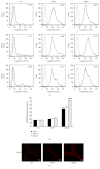Activation of the Nrf2-Keap 1 Pathway in Short-Term Iodide Excess in Thyroid in Rats
- PMID: 28133506
- PMCID: PMC5241484
- DOI: 10.1155/2017/4383652
Activation of the Nrf2-Keap 1 Pathway in Short-Term Iodide Excess in Thyroid in Rats
Abstract
Wistar rats were randomly divided into groups of varying iodide intake: normal iodide; 10 times high iodide; and 100 times high iodide on Days 7, 14, and 28. Insignificant changes were observed in thyroid hormone levels (p > 0.05). Urinary iodine concentration and iodine content in the thyroid glands increased after high consumption of iodide from NI to 100 HI (p < 0.05). The urinary iodine concentration of the 100 HI group on Days 7, 14, and 28 was 60-80 times that of the NI group. The mitochondrial superoxide production and expressions of Nrf2, Srx, and Prx 3 all significantly increased, while Keap 1 significantly decreased in the 100 HI group when compared to the NI or 10 HI group on Days 7, 14, and 28 (p < 0.05). Immunofluorescence staining results showed that Nrf2 was localized in the cytoplasm in NI group. Although Nrf2 was detected in both cytoplasm and nucleus in 10 HI and 100 HI groups, a stronger positive staining was found in the nucleus. We conclude that the activation of the Nrf2-Keap 1 antioxidative defense mechanism may play a crucial role in protecting thyroid function from short-term iodide excess in rats.
Conflict of interest statement
The authors declare that there is no conflict of interests regarding the publication of this article.
Figures





Similar articles
-
NFE2-Related Transcription Factor 2 Coordinates Antioxidant Defense with Thyroglobulin Production and Iodination in the Thyroid Gland.Thyroid. 2018 Jun;28(6):780-798. doi: 10.1089/thy.2018.0018. Thyroid. 2018. PMID: 29742982 Free PMC article.
-
Thyroid function alterations attributed to high iodide supplementation in maternal rats and their offspring.J Trace Elem Med Biol. 2018 May;47:89-97. doi: 10.1016/j.jtemb.2018.01.018. Epub 2018 Feb 2. J Trace Elem Med Biol. 2018. PMID: 29544812
-
[Mechanism of cardiac function changes in rat models of Sjogren's syndrome based on Keap1-Nrf2/ARE signaling pathways].Xi Bao Yu Fen Zi Mian Yi Xue Za Zhi. 2014 May;30(5):497-501. Xi Bao Yu Fen Zi Mian Yi Xue Za Zhi. 2014. PMID: 24796746 Chinese.
-
Emerging roles of Keap1/Nrf2 signaling in the thyroid gland and perspectives for bench-to-bedside translation.Free Radic Biol Med. 2022 Sep;190:276-283. doi: 10.1016/j.freeradbiomed.2022.08.021. Epub 2022 Aug 18. Free Radic Biol Med. 2022. PMID: 35988853 Review.
-
Chemopreventive promise of targeting the Nrf2 pathway.Drug News Perspect. 2007 Mar;20(2):109-17. doi: 10.1358/dnp.2007.20.2.108343. Drug News Perspect. 2007. PMID: 17440634 Review.
Cited by
-
Mechanistic insights into Nrf2-driven pathogenesis and therapeutic targeting in spinal cord injury.Front Immunol. 2025 Jul 10;16:1574834. doi: 10.3389/fimmu.2025.1574834. eCollection 2025. Front Immunol. 2025. PMID: 40709178 Free PMC article. Review.
-
Iodide intake during pregnancy and lactation stimulates KLF9, BDNF expression in offspring brain with elevated DHA, EPA metabolites.Heliyon. 2023 Jan 21;9(2):e13161. doi: 10.1016/j.heliyon.2023.e13161. eCollection 2023 Feb. Heliyon. 2023. PMID: 36816261 Free PMC article.
-
Effects of KEAP1 Silencing on the Regulation of NRF2 Activity in Neuroendocrine Lung Tumors.Int J Mol Sci. 2019 May 23;20(10):2531. doi: 10.3390/ijms20102531. Int J Mol Sci. 2019. PMID: 31126053 Free PMC article.
-
The Transcriptomic Response of the Murine Thyroid Gland to Iodide Overload and the Role of the Nrf2 Antioxidant System.Antioxidants (Basel). 2020 Sep 18;9(9):884. doi: 10.3390/antiox9090884. Antioxidants (Basel). 2020. PMID: 32961913 Free PMC article.
-
Nrf2 Regulates Oxidative Stress and Its Role in Cerebral Ischemic Stroke.Antioxidants (Basel). 2022 Nov 30;11(12):2377. doi: 10.3390/antiox11122377. Antioxidants (Basel). 2022. PMID: 36552584 Free PMC article. Review.
References
MeSH terms
Substances
LinkOut - more resources
Full Text Sources
Other Literature Sources

